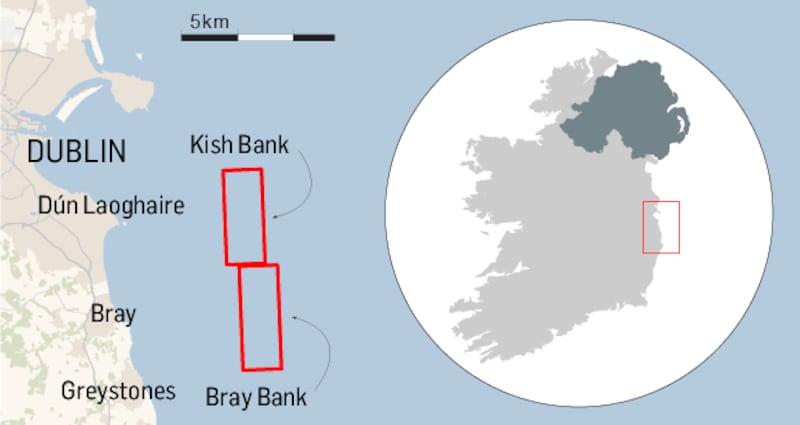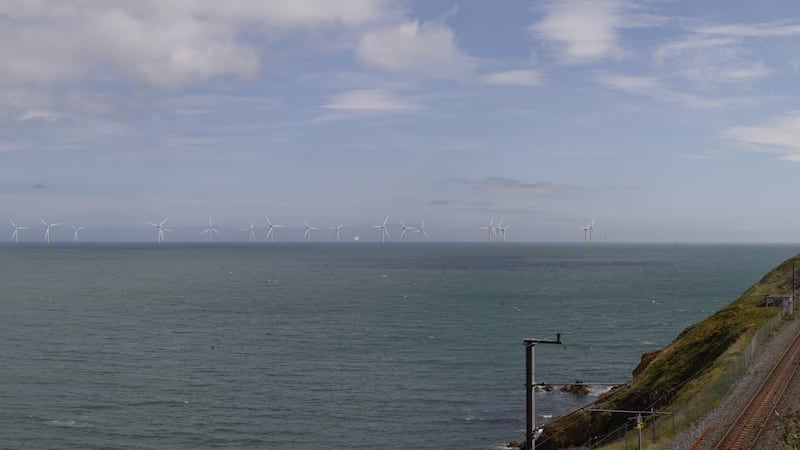The developers of a large offshore wind farm costing €1.5 billion, proposed for outer Dublin Bay and stretching south beyond Bray Head, have taken the unusual step of initiating public consultation in advance of completing a planning application.
German energy giant RWE and the Irish company Saorgus, plan to build the wind farm on the Kish and Bray Banks – known as Dublin Array – 10km off the east coast and close to the capital. It will be capable of generating enough electricity for up to 600,000 homes.
They have released photomontages indicating its visual impact. Large wind turbines are likely to be 310m in height when blade size is factored in, which will significantly change the seascape view from Dún Laoghaire almost as far as Greystones, Co Wicklow.
If approved, the view out to sea in the capital will become like some major European coastal cities where turbines are prominent, most notably in the Danish capital Copenhagen.
Dublin Array project director Peter Lefroy says the developers are conscious of visual impact, "especially as the Dublin region has never been exposed to a lot of wind energy in the past. This is why we have gone out early on consultation and are engaging with a wide range of stakeholders."

Technological advances
The location was chosen because of its proximity to where in Ireland there is most demand for electricity and the grid is strongest, Mr Lefroy says. It makes technical sense that the country's first major offshore wind facility should be near Dublin, he adds.
The wind energy sector has changed dramatically in recent years to building larger turbines but fewer of them due to technological advances, with marked reductions in development cost and price of resulting electricity. “This means we can deliver more electricity, more efficiently, with fewer turbines,” Mr Lefroy says.
Dublin Array is anticipating where the industry will be in five years’ time. That means turbines in the order of 135m tower height – totalling over 300m to “top of blade”.
As a consequence, they are planning to build between 45 and 61 turbines. When first proposed to Dublin Array, it was considering up to 145 turbines with a tip height of 160m. Details will be finalised once surveys are completed in coming months.
The Government insists overhauling cumbersome marine legislation will provide opportunities for public consultation on individual projects. Because of limitations imposed by Covid-19, Dublin Array's early consultation is being conducted online via www.dublinarray.com and social media channels up to November 20th.
In May, the Government designated seven offshore wind projects as “relevant projects” – six in the Irish Sea – meaning they will be fast-tracked through overhauled legislation designed to help scale up offshore wind energy. Dublin Array is one of the seven.
The programme for government has a five gigawatt (GW) target for offshore wind; the energy equivalent of power for about five million homes, phased in by 2030 – Dublin Array with up to 900 megawatts (MW) estimates it will provide about 18 per cent of this requirement.

New Bill
The SSE Ireland Arklow Bank facility is separately advancing as an extension of Ireland's original, and still only, operating offshore wind farm – a 25MW demonstrator project that opened in 2001. Up to 100 additional turbines are planned for the site 13km off the coast, south of Brittas Bay, Co Wicklow.
A key enabler to unlock offshore wind development will be the new Marine Planning and Development Management Bill, due to be enacted in early 2021, Lefroy says.
There will be some timelag enacting regulations and introducing new wind energy guidelines (WEGs). He expects the planning application will be submitted directly to An Bord Pleanála after that.
Currently they are updating environmental assessments; a grid application and documentation for the State’s renewal electricity support scheme. This is with a view to getting consent before the end of 2022. Construction is estimated to take two years with the facility becoming operational by late 2026/early 2027.
The legislation is critical not only for the project but for the industry as a whole, and especially for the public, Lefroy says. Up to now it was not suitable in dealing with projects of this scale, and not helpful in securing public buy-in, he argues. The new Bill is “a much more amenable and robust process and allows for public discussion”.
The Irish Sea is set to look very busy with developments off the east coast stretching almost from Co Louth to Co Wexford, Lefroy accepts. However, the location of the wind farms, he says, comes with significant positives: they are in the shallowest part of the Irish coast, which enable quicker delivery in a more cost-effective way.
Operational base
Early reaction to the plans indicates “a huge amount of positivity out there”, he says. “We are not going to convince everybody but we are certainly going to try to engage with everybody.”
Dublin Array will be serviced from a nearby harbour – they are currently looking at options from Howth to Wicklow. It will employ up to 100 people at an operational base. "It's a big opportunity for ports along the east coast. That is why are trying to get buy-in from local stakeholders and local authorities."
The new WEGs need to differentiate between onshore and offshore, he stresses; the former having to address landscape and noises issues mainly. With the latter, it’s about visual impact too but primarily seabed disturbance during construction and underwater noise impacts on marine life.
The guidelines are a critical part of the regulatory jigsaw “to give us certainty”.
The offshore requirements extend to evaluating impact on nearby marine mammals and seabirds as well as how developments interact with shipping and the fishing industry. Dublin Array’s location is on naturally occurring sandbanks which the busy east coast commercial shipping routes avoid due to the shallowness of the water, he notes.
A reduction in the length of the offshore transmission cables reduces the environmental impact and costs of construction. Operational costs are also reduced due to ease of access for maintenance and reduced transmission losses.
“Cost reductions in the construction and operation of the wind farm ultimately reduce the cost of energy to the consumer,” he says.











